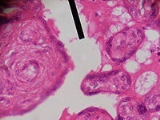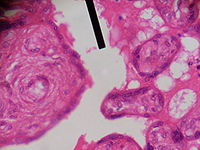
Intervillous space
Encyclopedia
As a brief introduction, "inter" means between, and "villous" means "pertaining to a villus (a hair-like projection)", which in this case contains blood vessels, so the intervillous space is the "space between the villi containing the vessels" of the mother and the embryo
.
The trophoblast
, which is a collection of cells that invades the maternal endometrium
to gain access to nutrition for the fetus, proliferates rapidly and forms a network of branching processes which cover the entire embryo
and invade and destroy the maternal tissues. With this physiologic destructive process, the maternal blood vessels of the endometrium are opened, with the result that the spaces in the trophoblastic network are filled with maternal blood; these spaces communicate freely with one another and become greatly distended and form the intervillous space from which the fetus gains nutrition.
Maternal arteries and veins directly enter the intervillous space after 8 weeks gestation, and the intervillous space will contain about a unit
of blood (400-500 mL). Much of this blood is returned to the mother with normal uterine contractions; thus, when a woman has a cesarean section, she is liable to lose more blood than a woman who has a vaginal delivery, as the blood from the intervillous space is not pushed back toward her body during such a delivery.

Embryo
An embryo is a multicellular diploid eukaryote in its earliest stage of development, from the time of first cell division until birth, hatching, or germination...
.
The trophoblast
Trophoblast
Trophoblasts are cells forming the outer layer of a blastocyst, which provide nutrients to the embryo and develop into a large part of the placenta. They are formed during the first stage of pregnancy and are the first cells to differentiate from the fertilized egg...
, which is a collection of cells that invades the maternal endometrium
Endometrium
-Function:The endometrium is the innermost glandular layer and functions as a lining for the uterus, preventing adhesions between the opposed walls of the myometrium, thereby maintaining the patency of the uterine cavity. During the menstrual cycle or estrous cycle, the endometrium grows to a...
to gain access to nutrition for the fetus, proliferates rapidly and forms a network of branching processes which cover the entire embryo
Embryo
An embryo is a multicellular diploid eukaryote in its earliest stage of development, from the time of first cell division until birth, hatching, or germination...
and invade and destroy the maternal tissues. With this physiologic destructive process, the maternal blood vessels of the endometrium are opened, with the result that the spaces in the trophoblastic network are filled with maternal blood; these spaces communicate freely with one another and become greatly distended and form the intervillous space from which the fetus gains nutrition.
Maternal arteries and veins directly enter the intervillous space after 8 weeks gestation, and the intervillous space will contain about a unit
Blood transfusion
Blood transfusion is the process of receiving blood products into one's circulation intravenously. Transfusions are used in a variety of medical conditions to replace lost components of the blood...
of blood (400-500 mL). Much of this blood is returned to the mother with normal uterine contractions; thus, when a woman has a cesarean section, she is liable to lose more blood than a woman who has a vaginal delivery, as the blood from the intervillous space is not pushed back toward her body during such a delivery.


